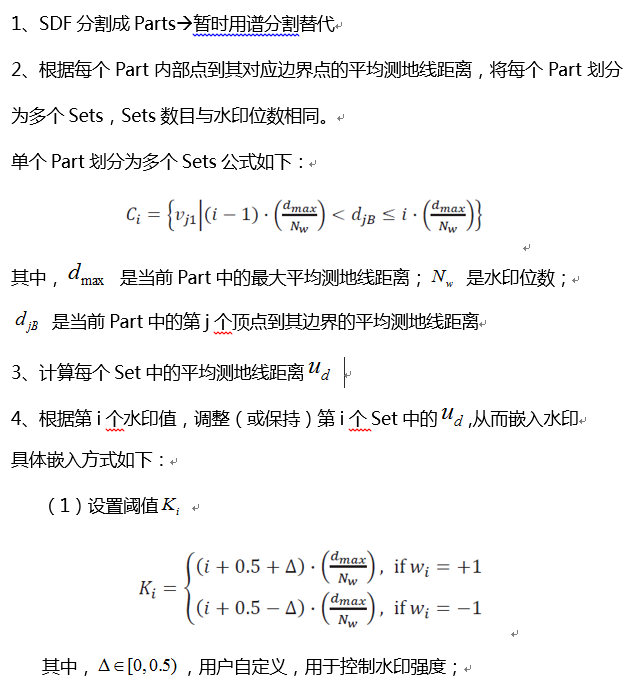计算网格模型各点之间测地线距离
计算网格模型各点之间测地线距离
写在前面
最近白天在做实验室的事情,晚上学一点iOS基础知识,两个事情进度都挺慢的,心里有点方啊。。。但是方也没办法,只能督促自己提高效率。目前实验室的任务是研究三维序列网格水印,在正式设计自己的代码前,先要实现一篇论文,这篇论文在之前的文章中也有讲过,大意是基于测地线距离的网格序列水印,文章整体思路如下:


整个算法的实现略复杂,由于SDF分割在CGAL库中有实现,所以花了好多时间来配置CGAL环境,但是最终还是不能运行样例代码,所以决定先用k-means分割替代。在这个算法中,需要计算区域内的顶点到区域边界的测地线距离。我们可以先计算网格上任意两点之间的测地线距离,然后根据需要取出某两点之间的测地线距离
代码
% fastmarch Fast marching algorithm for geodesic distance approximation
%
% Usage:
%
% D = fastmarch(TRIV, X, Y, Z, [src], [opt])
% D = fastmarch(surface, [src], [opt])
%
% Description:
%
% Computes the geodesic distances on a triangulated surfaces using
% the fast marching algorithm. The algorithm may operate in two modes:
% single-source and multiple-source. In the single-source mode, a distance
% map of every mesh vertex from a single source is computed. The source
% may be a single point on the mesh, or any other configuration described
% by an initial set of values per mesh vertex. In the multiple-source
% mode, a matrix of pair-wise geodesic distances is computed between a
% specified set of mesh vertices.
%
% Input:
%
% TRIV - ntx3 triangulation matrix with 1-based indices (as the one
% returned by the MATLAB function delaunay).
% X,Y,Z - vectors with nv vertex coordinates.
% surface - alternative way to specify the mesh as a struct, having .TRIV,
% .X, .Y, and .Z as its fields.
% src - in the multiple-source mode: (default: src = [1:nv])
% list of ns mesh vertex indices to be used as sources.
% in the single-source mode: (must be specified)
% an nvx1 list of initial values of the distance function on the mesh
% (set a vertex to Inf to exclude it from the source set). src
% opt - (optional) settings
% .mode - Mode (default: 'multiple')
% 'multiple' - multiple-source
% 'single' - single-source
%
% Output:
%
% D - In the multiple-source mode:
% nsxns matrix of approximate geodesic distances, where D(i,j) is
% the geodesic distance between the i-th and the j-th point,
% whose indices are specified by src(i) and src(j),
% respectively.
% In the single-source mode:
% nvx1 vector of approximated geodesic distances, where D(i) is
% the geodesic distance from the i-th mesh vertex to the
% source.
function [D,L] = fastmarch(TRIV, X, Y, Z, src, opt)
if nargin < 4,
surface = TRIV;
TRIV = surface.TRIV;
X = surface.X;
Y = surface.Y;
Z = surface.Z;
end
mode = 0;
if nargin > 5 & isfield(opt, 'mode'),
if strcmpi(opt.mode, 'multiple'),
mode = 0;
elseif strcmpi(opt.mode, 'single'),
mode = 1;
else
error('Invalid mode. Use either "multiple" or "single".');
end
end
if nargin == 1 | nargin == 4,
if mode == 0,
src = [1:length(X)];
else
error('Source set must be specified in single source mode.');
end
end
if mode & length(src) ~= length(X(:)),
error('src must be nvx1 in the single source mode.');
end
% MEX implementation
if ~mode,
[D] = fastmarch_mex(int32(TRIV-1), int32(src(:)-1), double(X(:)), double(Y(:)), double(Z(:)));
else
idx = find(src==0);
srclabel = zeros(length(src),1);
srclabel(idx) = 1:length(idx);
[D,L] = fastmarch1_mex(int32(TRIV-1), double([src(:); srclabel(:)]), double(X(:)), double(Y(:)), double(Z(:)));
end
D(D>=9999999) = Inf;
总结
具体的解释都写在代码中的注释里了,这里就不赘述了



